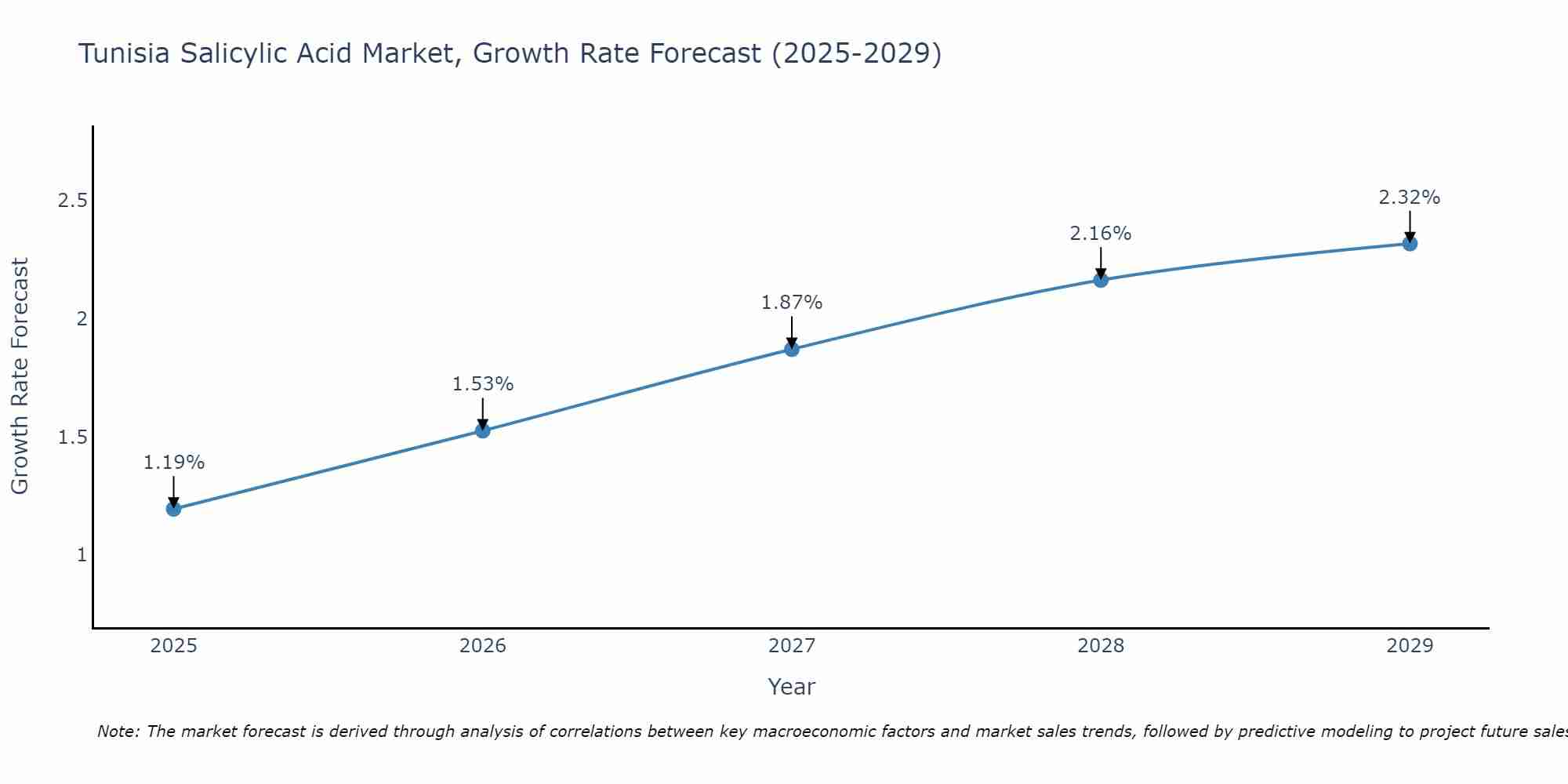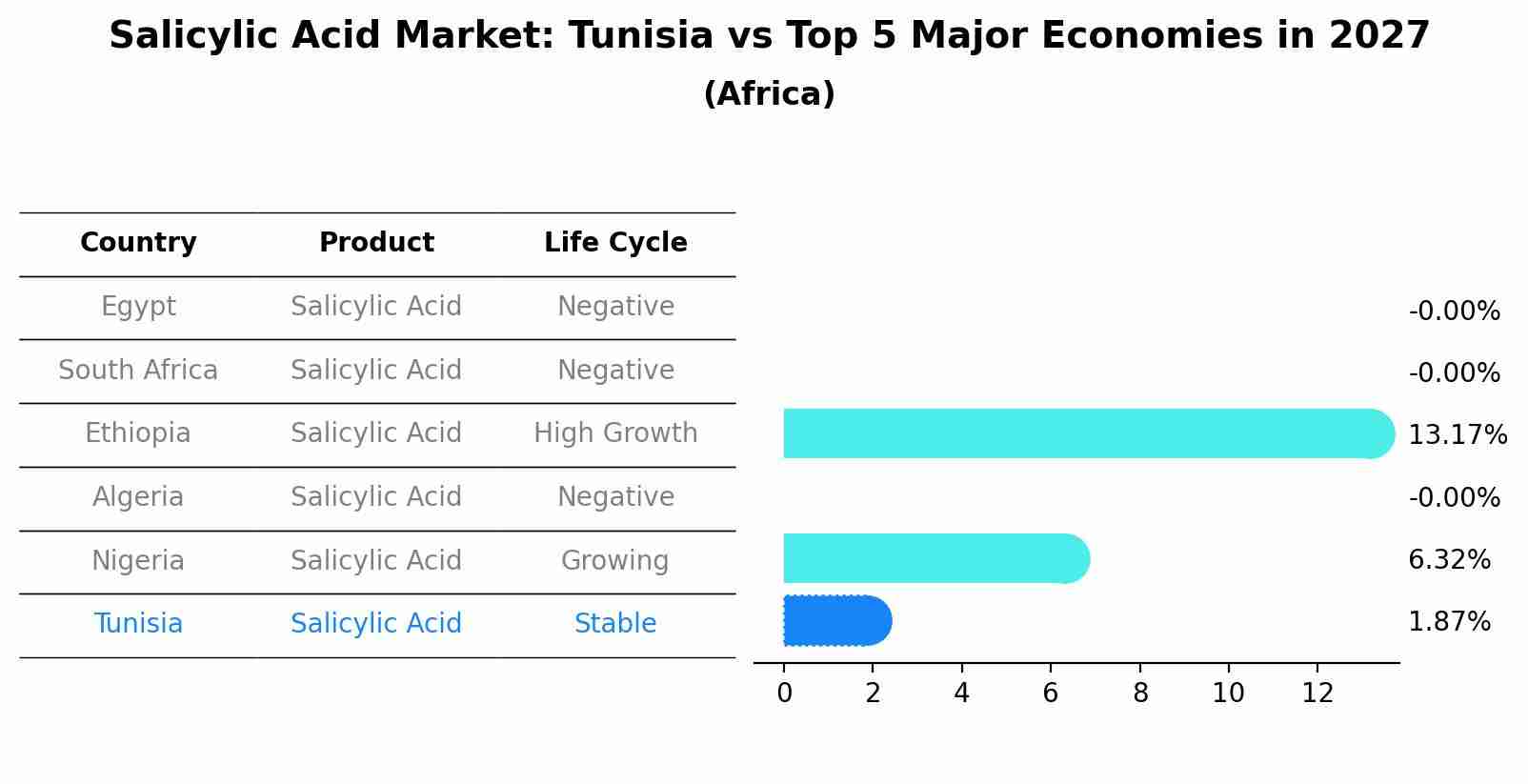Tunisia Salicylic Acid Market (2025-2031) Outlook | Revenue, Growth, Analysis, Size, Forecast, Companies, Trends, Share, Value & Industry
| Product Code: ETC102373 | Publication Date: Jun 2021 | Updated Date: Jun 2025 | Product Type: Report | |
| Publisher: 6Wresearch | Author: Shubham Padhi | No. of Pages: 70 | No. of Figures: 35 | No. of Tables: 5 |
Tunisia Salicylic Acid Market Size Growth Rate
The Tunisia Salicylic Acid Market is likely to experience consistent growth rate gains over the period 2025 to 2029. The growth rate starts at 1.19% in 2025 and reaches 2.32% by 2029.

Salicylic Acid Market: Tunisia vs Top 5 Major Economies in 2027 (Africa)
By 2027, Tunisia's Salicylic Acid market is forecasted to achieve a stable growth rate of 1.87%, with Egypt leading the Africa region, followed by South Africa, Ethiopia, Algeria and Nigeria.

Tunisia Salicylic Acid Market Overview
The Tunisia Salicylic Acid market is experiencing steady growth driven by increasing demand in the pharmaceutical, cosmetics, and personal care industries. Salicylic acid is widely used in skincare products for its anti-inflammatory and exfoliating properties, making it a popular ingredient in acne treatments and anti-aging products. The market is also seeing growth in the pharmaceutical sector due to the compound`s use in various medications, including those for acne, psoriasis, and other skin conditions. Key players in the Tunisia Salicylic Acid market include manufacturers, distributors, and suppliers catering to the diverse needs of the end-user industries. With a focus on product innovation and quality, the market is expected to continue its growth trajectory in the coming years.
Tunisia Salicylic Acid Market Trends
In Tunisia, the salicylic acid market is witnessing a growing demand driven by the increasing awareness of its benefits in skincare products. Consumers are becoming more conscious about the importance of incorporating salicylic acid in their skincare routines due to its exfoliating and acne-fighting properties. The market is also being fueled by the rise of the cosmetics industry and an influx of new product launches containing salicylic acid. Additionally, the trend towards natural and organic skincare products is influencing the market, leading to a preference for salicylic acid derived from natural sources such as willow bark. Overall, the Tunisia salicylic acid market is expected to continue its growth trajectory as consumers prioritize skincare solutions that offer effective and gentle exfoliation and acne treatment.
Tunisia Salicylic Acid Market Challenges
In the Tunisia Salicylic Acid Market, some challenges faced include stiff competition from imported products that may offer lower prices, the limited availability of high-quality raw materials locally, and the need for investment in research and development to keep up with evolving consumer preferences and industry trends. Additionally, regulatory constraints and bureaucratic processes may hinder market growth and innovation in the sector. Companies operating in the Tunisia Salicylic Acid Market need to navigate these challenges by focusing on product differentiation, cost-efficiency, and developing strategic partnerships to overcome obstacles and capitalize on opportunities for growth in the market.
Tunisia Salicylic Acid Market Investment Opportunities
The Tunisia Salicylic Acid Market presents several investment opportunities due to the growing demand for salicylic acid in various industries such as pharmaceuticals, cosmetics, and personal care products. With an increasing focus on skincare and healthcare products, there is a rising demand for salicylic acid as an active ingredient in acne treatments, anti-aging products, and hair care formulations. Investing in the production and distribution of salicylic acid in Tunisia can be lucrative, especially considering the country`s strategic location as a gateway to the African market. Additionally, with advancements in technology and research, there is potential for innovation and development of new applications for salicylic acid, further expanding the market opportunities in Tunisia.
Tunisia Salicylic Acid Market Government Policy
The Tunisian government has implemented various policies related to the Salicylic Acid Market to promote domestic production and reduce reliance on imports. These policies include providing financial incentives and support to local manufacturers, promoting research and development in the chemical industry, and implementing regulations to ensure product quality and safety. Additionally, the government has been focusing on enhancing trade agreements with other countries to facilitate the export of Salicylic Acid and boost the overall competitiveness of the Tunisian market. Overall, these policies aim to stimulate growth in the domestic Salicylic Acid industry, create job opportunities, and contribute to the country`s economic development.
Tunisia Salicylic Acid Market Future Outlook
The Tunisia Salicylic Acid market is expected to show steady growth in the coming years, driven by increasing demand from the pharmaceutical and cosmetics industries. The rising awareness about skincare and the benefits of salicylic acid in treating various skin conditions such as acne and psoriasis will further fuel market growth. Additionally, the growing emphasis on personal care and grooming among consumers is likely to boost the demand for salicylic acid-based products. However, factors such as volatility in raw material prices and regulatory challenges may pose some challenges to market growth. Overall, with the increasing focus on skincare and personal care products, the Tunisia Salicylic Acid market is poised for expansion in the forecast period.
Key Highlights of the Report:
- Tunisia Salicylic Acid Market Outlook
- Market Size of Tunisia Salicylic Acid Market, 2021
- Forecast of Tunisia Salicylic Acid Market, 2031
- Historical Data and Forecast of Tunisia Salicylic Acid Revenues & Volume for the Period 2021 - 2031
- Tunisia Salicylic Acid Market Trend Evolution
- Tunisia Salicylic Acid Market Drivers and Challenges
- Tunisia Salicylic Acid Price Trends
- Tunisia Salicylic Acid Porter's Five Forces
- Tunisia Salicylic Acid Industry Life Cycle
- Historical Data and Forecast of Tunisia Salicylic Acid Market Revenues & Volume By Application for the Period 2021 - 2031
- Historical Data and Forecast of Tunisia Salicylic Acid Market Revenues & Volume By Pharmaceutical for the Period 2021 - 2031
- Historical Data and Forecast of Tunisia Salicylic Acid Market Revenues & Volume By Food & Preservatives for the Period 2021 - 2031
- Historical Data and Forecast of Tunisia Salicylic Acid Market Revenues & Volume By Cosmetics for the Period 2021 - 2031
- Historical Data and Forecast of Tunisia Salicylic Acid Market Revenues & Volume By Others for the Period 2021 - 2031
- Tunisia Salicylic Acid Import Export Trade Statistics
- Market Opportunity Assessment By Application
- Tunisia Salicylic Acid Top Companies Market Share
- Tunisia Salicylic Acid Competitive Benchmarking By Technical and Operational Parameters
- Tunisia Salicylic Acid Company Profiles
- Tunisia Salicylic Acid Key Strategic Recommendations
Frequently Asked Questions About the Market Study (FAQs):
1 Executive Summary |
2 Introduction |
2.1 Key Highlights of the Report |
2.2 Report Description |
2.3 Market Scope & Segmentation |
2.4 Research Methodology |
2.5 Assumptions |
3 Tunisia Salicylic Acid Market Overview |
3.1 Tunisia Country Macro Economic Indicators |
3.2 Tunisia Salicylic Acid Market Revenues & Volume, 2021 & 2031F |
3.3 Tunisia Salicylic Acid Market - Industry Life Cycle |
3.4 Tunisia Salicylic Acid Market - Porter's Five Forces |
3.5 Tunisia Salicylic Acid Market Revenues & Volume Share, By Form, 2021 & 2031F |
4 Tunisia Salicylic Acid Market Dynamics |
4.1 Impact Analysis |
4.2 Market Drivers |
4.3 Market Restraints |
5 Tunisia Salicylic Acid Market Trends |
6 Tunisia Salicylic Acid Market, By Types |
6.1 Tunisia Salicylic Acid Market, By Application |
6.1.1 Overview and Analysis |
6.1.2 Tunisia Salicylic Acid Market Revenues & Volume, By Application, 2018 - 2027F |
6.1.3 Tunisia Salicylic Acid Market Revenues & Volume, By Pharmaceutical, 2018 - 2027F |
6.1.4 Tunisia Salicylic Acid Market Revenues & Volume, By Food & Preservatives, 2018 - 2027F |
6.1.5 Tunisia Salicylic Acid Market Revenues & Volume, By Cosmetics, 2018 - 2027F |
6.1.6 Tunisia Salicylic Acid Market Revenues & Volume, By Others, 2018 - 2027F |
7 Tunisia Salicylic Acid Market Import-Export Trade Statistics |
7.1 Tunisia Salicylic Acid Market Export to Major Countries |
7.2 Tunisia Salicylic Acid Market Imports from Major Countries |
8 Tunisia Salicylic Acid Market Key Performance Indicators |
9 Tunisia Salicylic Acid Market - Opportunity Assessment |
9.1 Tunisia Salicylic Acid Market Opportunity Assessment, By Application, 2021 & 2031F |
10 Tunisia Salicylic Acid Market - Competitive Landscape |
10.1 Tunisia Salicylic Acid Market Revenue Share, By Companies, 2021 |
10.2 Tunisia Salicylic Acid Market Competitive Benchmarking, By Operating and Technical Parameters |
11 Company Profiles |
12 Recommendations |
13 Disclaimer |
- Single User License$ 1,995
- Department License$ 2,400
- Site License$ 3,120
- Global License$ 3,795
Search
Thought Leadership and Analyst Meet
Our Clients
Related Reports
- Afghanistan Apparel Market (2026-2032) | Growth, Outlook, Industry, Segmentation, Forecast, Size, Companies, Trends, Value, Share, Analysis & Revenue
- Canada Oil and Gas Market (2026-2032) | Share, Segmentation, Value, Industry, Trends, Forecast, Analysis, Size & Revenue, Growth, Competitive Landscape, Outlook, Companies
- Germany Breakfast Food Market (2026-2032) | Industry, Share, Growth, Size, Companies, Value, Analysis, Revenue, Trends, Forecast & Outlook
- Australia Briquette Market (2025-2031) | Growth, Size, Revenue, Forecast, Analysis, Trends, Value, Share, Industry & Companies
- Vietnam System Integrator Market (2025-2031) | Size, Companies, Analysis, Industry, Value, Forecast, Growth, Trends, Revenue & Share
- ASEAN and Thailand Brain Health Supplements Market (2025-2031) | Strategy, Consumer Insights, Analysis, Investment Trends, Opportunities, Growth, Size, Share, Industry, Revenue, Segments, Value, Segmentation, Supply, Forecast, Restraints, Outlook, Competition, Drivers, Trends, Demand, Pricing Analysis, Competitive, Strategic Insights, Companies, Challenges
- ASEAN Bearings Market (2025-2031) | Strategy, Consumer Insights, Analysis, Investment Trends, Opportunities, Growth, Size, Share, Industry, Revenue, Segments, Value, Segmentation, Supply, Forecast, Restraints, Outlook, Competition, Drivers, Trends, Demand, Pricing Analysis, Competitive, Strategic Insights, Companies, Challenges
- Europe Flooring Market (2025-2031) | Outlook, Share, Industry, Trends, Forecast, Companies, Revenue, Size, Analysis, Growth & Value
- Saudi Arabia Manlift Market (2025-2031) | Outlook, Size, Growth, Trends, Companies, Industry, Revenue, Value, Share, Forecast & Analysis
- Uganda Excavator, Crane, and Wheel Loaders Market (2025-2031) | Strategy, Consumer Insights, Analysis, Investment Trends, Opportunities, Growth, Size, Share, Industry, Revenue, Segments, Value, Segmentation, Supply, Forecast, Restraints, Outlook, Competition, Drivers, Trends, Demand, Pricing Analysis, Competitive, Strategic Insights, Companies, Challenges
Industry Events and Analyst Meet
Whitepaper
- Middle East & Africa Commercial Security Market Click here to view more.
- Middle East & Africa Fire Safety Systems & Equipment Market Click here to view more.
- GCC Drone Market Click here to view more.
- Middle East Lighting Fixture Market Click here to view more.
- GCC Physical & Perimeter Security Market Click here to view more.
6WResearch In News
- Doha a strategic location for EV manufacturing hub: IPA Qatar
- Demand for luxury TVs surging in the GCC, says Samsung
- Empowering Growth: The Thriving Journey of Bangladesh’s Cable Industry
- Demand for luxury TVs surging in the GCC, says Samsung
- Video call with a traditional healer? Once unthinkable, it’s now common in South Africa
- Intelligent Buildings To Smooth GCC’s Path To Net Zero


















